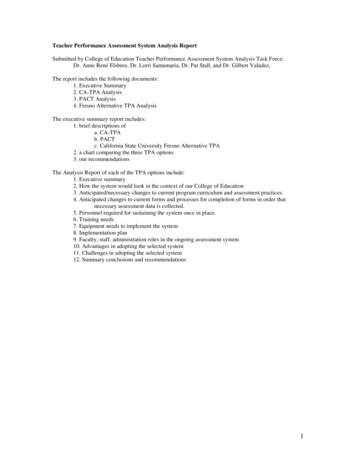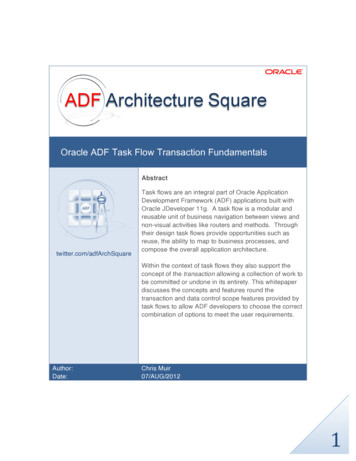
Transcription
D208 Performance Assessment NBM2 Task 2 revision2July 22, 2021Logistic Regression for Predictive ModelingStudent ID: 001826691Masters Data Analytics (12/01/2020)Program Mentor: Dan Estes385-432-9281 (MST)rbuch49@wgu.eduRyan L. BuchananA1. Research Question: Can we determine which individual customers are at high risk ofchurn? And, can we determine which features are most significant to churn?A2. Objectives & Goals: Stakeholders in the company will benefit by knowing, with somemeasure of confidence, which customers are likely to churn soon. This knowledge will provideweight for decisions in marketing improved services to customers with these characteristics &past user experiences.B1. Summary of Assumptions:Assumptions of a logistic regression model include: It is based on Bernoulli (also, Binomial or Boolean) Distribution rather than Gaussian because the dependent variable is binary (in our dataset, to churn or not to churn). The predicted values are restricted to a range of nomial values: Yes or No. It predicts the probability of a particular outcome rather than the outcome itself. There are no high correlations (multicollinearity) among predictors. It is the logarithm of the odds of achieving 1. In other words, a regression model, wherethe output is natural logarithm of the odds, also known as logit.B2. Tool Benefits: Python & IPython Jupyter notebooks will be used to support this analysis.Python offers an intuitive, simple & versatile programming style & syntax, as well as a large system of mature packages for data science & machine learning. Since, Python is cross-platform,it will work well whether consumers of the analysis are using Windows PCs or a MacBook laptop. It is fast when compared with other possible programming languages like R or MATLAB(Massaron, p. 8). Also, there is strong support for Python as the most popular data science programming language in popular literature & media (CBTNuggets, p. 1).1
B3. Appropriate Technique: Logistic regression is an appropriate technique to analyze the research question because or dependent variable is binomial, Yes or No. We want to find out whatthe likelihood of customer churn is for individual customers, based on a list of independent variables (area type, job, children, age, income, etc.). It will improve our understanding of increasedprobability of churn as we include or remove different independent variables & find out whetheror not they have a positive or negative relationship to our target variable.C1. Data Goals: My approach will include: 1. Back up my data and the process I am followingas a copy to my machine and, since this is a manageable dataset, to GitHub using command lineand gitbash. 2. Read the data set into Python using Pandas’ read csv command. 3. Evaluate thedata struture to better understand input data. 4. Naming the dataset as a the variable "churn df"and subsequent useful slices of the dataframe as "df". 5. Examine potential misspellings, awkward variable naming & missing data. 6. Find outliers that may create or hide statistical significance using histograms. 7. Imputing records missing data with meaningful measures of centraltendency (mean, median or mode) or simply remove outliers that are several standard deviationsabove the mean.Most relevant to our decision making process is the dependent variable of "Churn" which isbinary categorical with only two values, Yes or No. Churn will be our categorical target variable.In cleaning the data, we may discover relevance of the continuous predictor variables: ChildrenIncomeOutage sec perweekEmailContacts Yearly equip failureTenure (the number of months the customer has stayed with the provider)MonthlyChargeBandwidth GB YearLikewise, we may discover relevance of the categorical predictor variables (all binary categorical with only two values, Yes or No, except where noted): Techie: Whether the customer considers themselves technically inclined (based on customerquestionnaire when they signed up for services) (yes, no) Contract: The contract term of the customer (month-to-month, one year, two year) Port modem: Whether the customer has a portable modem (yes, no) Tablet: Whether the customer owns a tablet such as iPad, Surface, etc. (yes, no) InternetService: Customer’s internet service provider (DSL, fiber optic, None) Phone: Whether the customer has a phone service (yes, no) Multiple: Whether the customer has multiple lines (yes, no) OnlineSecurity: Whether the customer has an online security add-on (yes, no) OnlineBackup: Whether the customer has an online backup add-on (yes, no) DeviceProtection: Whether the customer has device protection add-on (yes, no) TechSupport: Whether the customer has a technical support add-on (yes, no) StreamingTV: Whether the customer has streaming TV (yes, no) StreamingMovies: Whether the customer has streaming movies (yes, no)2
Finally, discrete ordinal predictor variables from the survey responses from customers regarding various customer service features may be relevant in the decision-making process. In thesurveys, customers provided ordinal numerical data by rating 8 customer service factors on ascale of 1 to 8 (1 most important, 8 least important): mely responseTimely fixesTimely replacementsReliabilityOptionsRespectful responseCourteous exchangeEvidence of active listeningC2. Summary Statistics: As output by Python pandas dataframe methods below, the datasetconsists of 50 original columns & 10,000 records. For purposes of this analysis certain user ID &demographic categorical variables (CaseOrder, Customer id, Interaction, UID, City, State, County,Zip, Lat, Lng, Population, Area, TimeZone, Job, Marital, PaymentMethod) were removed from thedataframe. Also, binomial Yes/No or Male/Female, variables were encoded to 1/0, respectively.This resulted in 34 remaining numerical variables, including the target variable.The datasetappeared to be sufficiently cleaned leaving no null, NAs or missing data points.Measures of central tendency through histograms & boxplots revealed normal distributionsfor Monthly Charge, Outage sec perweek & Email. The cleaned dataset no longer retained anyoutliers. Histograms for Bandwidth GB Year & Tenure displayed bimodal distributions, whichdemonstrated a direct linear relationship with each other in a scatterplot. The average customerwas 53 years-old (with a standard deviation of 20 years), had 2 children (with a standard deviationof 2 kids), an income of 39,806 (with a standard deviation of about 30,000), experienced 10 outageseconds/week, was marketed to by email 12 times, contacted technical support less than onetime, had less than 1 yearly equipment failure, has been with the company for 34.5 months, has amonthly charge of approximately 173 & uses 3,392 GBs/year.C3. Steps to Prepare Data: Import dataset to Python dataframe. Rename columns/variables of survey to easily recognizable features (ex: Item1 to TimelyResponse). Get a description of dataframe, structure (columns & rows) & data types. View summary statistics. Drop less meaningful identifying (ex: Customer id) & demographic columns (ex: zip code)from dataframe. Check for records with missing data & impute missing data with meaningful measures ofcentral tendency (mean, median or mode) or simply remove outliers that are several standard deviations above the mean. Create dummy variables in order to encode categorical, yes/no data points into 1/0 numerical values. View univariate & bivariate visualizations. Place target variable (the intercept) Churn at end of dataframe Finally, the prepared dataset will be extracted & provided as churn prepared log.csv.3
[62]: # Increase Jupyter display cell-widthfrom IPython.core.display import display, HTMLdisplay(HTML(" style .container { width:75% !important; } /style ")) IPython.core.display.HTML object [63]: # Standard data science importsimport numpy as npimport pandas as pdfrom pandas import Series, DataFrame# Visualization librariesimport seaborn as snsimport matplotlib.pyplot as plt%matplotlib inline# Statistics packagesimport pylabfrom pylab import rcParamsimport statsmodels.api as smimport statisticsfrom scipy import stats# Scikit-learnimport sklearnfrom sklearn import preprocessingfrom sklearn.linear model import LinearRegressionfrom sklearn.model selection import train test splitfrom sklearn import metricsfrom sklearn.metrics import classification report# Import chisquare from SciPy.statsfrom scipy.stats import chisquarefrom scipy.stats import chi2 contingency# Ignore Warning Codeimport warningswarnings.filterwarnings('ignore')[64]: # Change color of Matplotlib fontimport matplotlib as mplCOLOR 'white'mpl.rcParams['text.color'] COLORmpl.rcParams['axes.labelcolor'] COLORmpl.rcParams['xtick.color'] COLOR4
mpl.rcParams['ytick.color'] COLOR[65]: # Load data set into Pandas dataframechurn df pd.read csv('churn clean.csv')# Rename last 8 survey columns for better description of variableschurn df.rename(columns 'Item8':'Listening'},inplace True)[66]: # Display Churn dataframechurn df[66]:01234.99959996999799989999CaseOrder Customer 7939997D8617329998I2434059999I64161710000T38070. Courteous Listening.34.44.33.33.45.23.25.45.54.41[10000 rows x 50 columns][67]: # List of Dataframe Columnsdf churn df.columnsprint(df)Index(['CaseOrder', 'Customer id', 'Interaction', 'UID', 'City', 'State','County', 'Zip', 'Lat', 'Lng', 'Population', 'Area', 'TimeZone', 'Job','Children', 'Age', 'Income', 'Marital', 'Gender', 'Churn','Outage sec perweek', 'Email', 'Contacts', 'Yearly equip failure','Techie', 'Contract', 'Port modem', 'Tablet', 'InternetService','Phone', 'Multiple', 'OnlineSecurity', 'OnlineBackup','DeviceProtection', 'TechSupport', 'StreamingTV', 'StreamingMovies','PaperlessBilling', 'PaymentMethod', 'Tenure', 'MonthlyCharge','Bandwidth GB Year', 'TimelyResponse', 'Fixes', 'Replacements','Reliability', 'Options', 'Respectfulness', 'Courteous', 'Listening'],dtype 'object')5
[68]: # Find number of records and columns of datasetchurn df.shape[68]: (10000, 50)[69]: # Describe Churn dataset statisticschurn 0003.0000003.0000004.0000008.000000[8 rows x 23 columns][70]: # Remove less meaningful demographic variables from statistics descriptionchurn df churn df.drop(columns ['CaseOrder', 'Customer id', 'Interaction', , 'UID', 'City','State', 'County', 'Zip', 'Lat', 'Lng', , 'Population','Area', 'TimeZone', 'Job', 'Marital', , 'PaymentMethod'])churn 00007.000000[8 rows x 18 columns][71]: # Discover missing data points within datasetdata nulls churn df.isnull().sum()print(data 04.0000008.000000
Outage sec perweekEmailContactsYearly equip failureTechieContractPort rgeBandwidth GB onsRespectfulnessCourteousListeningdtype: int6400000000000000000000000000000Dummy variable data preparation[72]: churn df['DummyGender'] [1 if v 'Male' else 0 for v in churn df['Gender']]churn df['DummyChurn'] [1 if v 'Yes' else 0 for v in churn df['Churn']] , ### If the customer left (churned) they get a '1'churn df['DummyTechie'] [1 if v 'Yes' else 0 for v in churn df['Techie']]churn df['DummyContract'] [1 if v 'Two Year' else 0 for v in , churn df['Contract']]churn df['DummyPort modem'] [1 if v 'Yes' else 0 for v in , churn df['Port modem']]churn df['DummyTablet'] [1 if v 'Yes' else 0 for v in churn df['Tablet']]churn df['DummyInternetService'] [1 if v 'Fiber Optic' else 0 for v in , churn df['InternetService']]churn df['DummyPhone'] [1 if v 'Yes' else 0 for v in churn df['Phone']]churn df['DummyMultiple'] [1 if v 'Yes' else 0 for v in , churn df['Multiple']]7
churn df['DummyOnlineSecurity'] [1 if v 'Yes' else 0 for v in , churn df['OnlineSecurity']]churn df['DummyOnlineBackup'] [1 if v 'Yes' else 0 for v in , churn df['OnlineBackup']]churn df['DummyDeviceProtection'] [1 if v 'Yes' else 0 for v in , churn df['DeviceProtection']]churn df['DummyTechSupport'] [1 if v 'Yes' else 0 for v in , churn df['TechSupport']]churn df['DummyStreamingTV'] [1 if v 'Yes' else 0 for v in , churn df['StreamingTV']]churn df['StreamingMovies'] [1 if v 'Yes' else 0 for v in , churn df['StreamingMovies']]churn df['DummyPaperlessBilling'] [1 if v 'Yes' else 0 for v in , churn df['PaperlessBilling']][73]: churn yStreamingTV DummyPaperlessBilling0111011110[5 rows x 49 columns][74]: # Drop original categorical features from dataframechurn df churn df.drop(columns ['Gender', 'Churn', 'Techie', 'Contract', , 'Port modem', 'Tablet','InternetService', 'Phone', 'Multiple', , 'OnlineSecurity','OnlineBackup', 'DeviceProtection', , 'TechSupport','StreamingTV', 'StreamingMovies', , 'PaperlessBilling'])churn 0001.0000001.000000[8 rows x 33 0.4921840.0000000.0000001.0000001.0000001.000000
[75]: df churn df.columnsprint(df)Index(['Children', 'Age', 'Income', 'Outage sec perweek', 'Email', 'Contacts','Yearly equip failure', 'Tenure', 'MonthlyCharge', 'Bandwidth GB Year','TimelyResponse', 'Fixes', 'Replacements', 'Reliability', 'Options','Respectfulness', 'Courteous', 'Listening', 'DummyGender', 'DummyChurn','DummyTechie', 'DummyContract', 'DummyPort modem', 'DummyTablet','DummyInternetService', 'DummyPhone', 'DummyMultiple','DummyOnlineSecurity', 'DummyOnlineBackup', 'DummyDeviceProtection','DummyTechSupport', 'DummyStreamingTV', 'DummyPaperlessBilling'],dtype 'object')[76]: # Move DummyChurn to end of dataset as targetchurn df churn df[['Children', 'Age', 'Income', 'Outage sec perweek', , 'Email', 'Contacts','Yearly equip failure', 'Tenure', 'MonthlyCharge', 'Bandwidth GB Year','TimelyResponse', 'Fixes', 'Replacements','Reliability', 'Options', 'Respectfulness', 'Courteous', 'Listening','DummyGender', 'DummyTechie', 'DummyContract','DummyPort modem', 'DummyTablet', 'DummyInternetService', 'DummyPhone','DummyMultiple', 'DummyOnlineSecurity', 'DummyOnlineBackup','DummyDeviceProtection', 'DummyTechSupport', 'DummyStreamingTV','DummyPaperlessBilling', 'DummyChurn']][77]: df churn df.columnsprint(df)Index(['Children', 'Age', 'Income', 'Outage sec perweek', 'Email', 'Contacts','Yearly equip failure', 'Tenure', 'MonthlyCharge', 'Bandwidth GB Year','TimelyResponse', 'Fixes', 'Replacements', 'Reliability', 'Options','Respectfulness', 'Courteous', 'Listening', 'DummyGender','DummyTechie', 'DummyContract', 'DummyPort modem', 'DummyTablet','DummyInternetService', 'DummyPhone', 'DummyMultiple','DummyOnlineSecurity', 'DummyOnlineBackup', 'DummyDeviceProtection','DummyTechSupport', 'DummyStreamingTV', 'DummyPaperlessBilling','DummyChurn'],dtype 'object')C4. Visualizations:[78]: # Visualize missing values in dataset# Install appropriate library!pip install missingno# Importing the librariesimport missingno as msno9
# Visualize missing values as a matrixmsno.matrix(churn df);Requirement already satisfied: missingno in /usr/local/lib/python3.7/distpackages (0.5.0)Requirement already satisfied: seaborn in /usr/local/lib/python3.7/dist-packages(from missingno) (0.11.1)Requirement already satisfied: matplotlib in /usr/local/lib/python3.7/distpackages (from missingno) (3.2.2)Requirement already satisfied: scipy in /usr/local/lib/python3.7/dist-packages(from missingno) (1.4.1)Requirement already satisfied: numpy in /usr/local/lib/python3.7/dist-packages(from missingno) (1.19.5)Requirement already satisfied: cycler 0.10 in /usr/local/lib/python3.7/distpackages (from matplotlib- missingno) (0.10.0)Requirement already satisfied: kiwisolver 1.0.1 in /usr/local/lib/python3.7/dist-packages (from matplotlib- missingno) (1.3.1)Requirement already satisfied: python-dateutil 2.1 in /usr/local/lib/python3.7/dist-packages (from matplotlib- missingno) (2.8.1)Requirement already satisfied: pyparsing! 2.0.4,! 2.1.2,! 2.1.6, 2.0.1 in/usr/local/lib/python3.7/dist-packages (from matplotlib- missingno) (2.4.7)Requirement already satisfied: six in /usr/local/lib/python3.7/dist-packages(from cycler 0.10- matplotlib- missingno) (1.15.0)Requirement already satisfied: pandas 0.23 in /usr/local/lib/python3.7/distpackages (from seaborn- missingno) (1.1.5)Requirement already satisfied: pytz 2017.2 in /usr/local/lib/python3.7/distpackages (from pandas 0.23- seaborn- missingno) (2018.9)10
Univariate Statistics[79]: # Create histograms of contiuous variableschurn df[['Children', 'Age', 'Income', 'Outage sec perweek', 'Email','Contacts', 'Yearly equip failure', 'Tenure', 'MonthlyCharge','Bandwidth GB Year']].hist()plt.savefig('churn pyplot.jpg')plt.tight layout()[80]: # Create Seaborn boxplots for continuous variablessns.boxplot('Tenure', data churn df)plt.show()11
[81]: sns.boxplot('MonthlyCharge', data churn df)plt.show()12
[82]: sns.boxplot('Bandwidth GB Year', data churn df)plt.show()AnomaliesIt appears that anomolies have been removed from the supplied dataset,churn clean.csv. There are no remaining outliers.Bivariate Statistics[83]: # Run scatterplots to show direct or inverse relationships between target & , independent variablessns.scatterplot(x churn df['Children'], y churn df['DummyChurn'], color 'red')plt.show();13
[84]: sns.scatterplot(x churn df['Age'], y churn df['DummyChurn'], color 'red')plt.show();14
[85]: sns.scatterplot(x churn df['Income'], y churn df['DummyChurn'], color 'red')plt.show();[86]: sns.scatterplot(x churn df['DummyGender'], y churn df['DummyChurn'], , color 'red')plt.show();15
[87]: sns.scatterplot(x churn df['Outage sec perweek'], y churn df['DummyChurn'], , color 'red')plt.show();16
[88]: sns.scatterplot(x churn df['Email'], y churn df['DummyChurn'], color 'red')plt.show();[89]: sns.scatterplot(x churn df['Contacts'], y churn df['DummyChurn'], color 'red')plt.show();17
[90]: sns.scatterplot(x churn df['Yearly equip failure'], y churn df['DummyChurn'], , color 'red')plt.show();[91]: sns.scatterplot(x churn df['DummyTechie'], y churn df['DummyChurn'], , color 'red')plt.show();18
[92]: sns.scatterplot(x churn df['Tenure'], y churn df['DummyChurn'], color 'red')plt.show();19
[93]: sns.scatterplot(x churn df['MonthlyCharge'], y churn df['DummyChurn'], , color 'red')plt.show();[94]: sns.scatterplot(x churn df['Bandwidth GB Year'], y churn df['DummyChurn'], , color 'red')plt.show();20
[95]: sns.scatterplot(x churn df['TimelyResponse'], y churn df['DummyChurn'], , color 'red')plt.show();21
[96]: sns.scatterplot(x churn df['Fixes'], y churn df['DummyChurn'], color 'red')plt.show();[97]: sns.scatterplot(x churn df['Replacements'], y churn df['DummyChurn'], , color 'red')plt.show();22
[98]: sns.scatterplot(x churn df['Reliability'], y churn df['DummyChurn'], , color 'red')plt.show();23
[99]: sns.scatterplot(x churn df['Options'], y churn df['DummyChurn'], color 'red')plt.show();[100]: sns.scatterplot(x churn df['Respectfulness'], y churn df['DummyChurn'], , color 'red')plt.show();24
[101]: sns.scatterplot(x churn df['Courteous'], y churn df['DummyChurn'], color 'red')plt.show();25
[102]: sns.scatterplot(x churn df['Listening'], y churn df['DummyChurn'], color 'red')plt.show();[103]: sns.scatterplot(x churn df['MonthlyCharge'], y churn df['Outage sec perweek'], , color 'red')plt.show();26
Scatterplot Summary These scatterplots suggest no correlation between a customer churning(Churn 1) & any of our continous user data points or categorical responses to survey data points.C5. Prepared Dataset:[104]: # Extract Clean datasetchurn df.to csv('churn prepared log.csv')D1. Initial Model[105]: """Develop the initial estimated regression equation that could be used to , predict the probability of customer churn, given the only continuous , variables"""churn df pd.read csv('churn prepared log.csv')churn df['intercept'] 1churn df pd.get dummies(churn df, drop first True)churn logit model sm.Logit(churn df['DummyChurn'], churn df[['Children', , 'Age','Income', , 'Outage sec perweek','Email', , 'Contacts',27
, 'Yearly equip failure',, 'MonthlyCharge',, 'Bandwidth GB Year',, 'TimelyResponse', 'Fixes',, 'Reliability',, 'Respectfulness',, 'Listening','Tenure', 'Replacements', 'Options', 'Courteous', 'intercept']]).fit()print(churn logit model.summary()), Optimization terminated successfully.Current function value: 0.319573Iterations 8Logit Regression Results Dep. Variable:DummyChurnNo. Observations:10000Model:LogitDf Residuals:9981Method:MLEDf Model:18Date:Thu, 22 Jul 2021Pseudo nverged:TrueLL-Null:-5782.2Covariance Type:nonrobustLLR p-value:0.000 coefstd errzP z 4500.653-1.68e-062.69e-06Outage sec 640.445-0.03828
0.087Yearly equip 620.00127.3440.0000.0240.028Bandwidth GB .42900.369-14.7090.000-6.152-4.706 Dummy Variables Now, we will run a model including all encoded categorical dummy variables.[106]: """"Model including all dummy variables"""churn df pd.read csv('churn prepared log.csv')churn df['intercept'] 1churn df pd.get dummies(churn df, drop first True)churn logit model2 sm.Logit(churn df['DummyChurn'], churn df[['Children', , 'Age','Income', , 'Outage sec perweek','Email', , 'Contacts', , 'Yearly equip failure','DummyTechie', , 'DummyContract',29
, 'DummyPort modem', 'DummyTablet',, 'DummyInternetService', 'DummyPhone',, 'DummyOnlineSecurity',, 'DummyOnlineBackup', 'DummyDeviceProtection',, 'DummyTechSupport', 'DummyStreamingTV',, 'DummyPaperlessBilling',, 'MonthlyCharge', 'Bandwidth GB Year',, 'TimelyResponse', 'Fixes',, 'Reliability',, 'Respectfulness',, 'Listening', 'DummyMultiple', 'Tenure', 'Replacements', 'Options', 'Courteous', 'intercept']]).fit()print(churn logit model2.summary()), Optimization terminated successfully.Current function value: 0.271990Iterations 8Logit Regression Results Dep. Variable:DummyChurnNo. Observations:10000Model:LogitDf Residuals:9968Method:MLEDf Model:31Date:Thu, 22 Jul 2021Pseudo nverged:TrueLL-Null:-5782.2Covariance Type:nonrobustLLR p-value:0.000 coefstd errzP z hildren-0.03950.018-2.2320.026-0.074-0.00530
Age0.011Income2.5e-06Outage sec perweek0.025Email0.021Contacts0.098Yearly equip myPort Charge0.050Bandwidth GB 0460.3110.755-0.07631
691-5.026 Early Model Comparison Following the second run of our MLE model, our pseudo R went upfrom 0.4473 to 0.5296 as we added in our categorical dummy variables to our continuous variables. We will take that as a good sign that some of the explanation of our variance is within thecategorical data points. We will use those 31 variables as our initial regression equation.Initial Multiple Linear Regression Model With 31 independent variables (18 continuous &13 categorical): y -5.8583 (-0.0395 * Children) (0.0069 * Age) (1.199e-07 * Income) (-0.0020 * Outage sec perweek) (-0.0015 * Email) (0.0301 * Contacts) (-0.0308 *Yearly equip failure) (0.7956 * DummyTechie) (-2.295 * DummyContract) (0.161 * DummyPort modem) (-0.0796 * DummyTablet) (-1.4252 * DummyInternetService) (-0.3157 *DummyPhone) (-0.2908 * DummyMultiple) (-0.3280 * DummyOnlineSecurity) (-0.5125* DummyOnlineBackup) (-0.41 * DummyDeviceProtection) (-0.3461 * DummyTechSupport) (0.0311 * DummyStreamingTV) (0.1126 * DummyPaperlessBilling) (-0.2043 * Tenure) (0.0461 * MonthlyCharge) (0.0013 * Bandwidth GB Year) (-0.0167 * TimelyResponse) (0.0143 * Fixes) (-0.0158 * Replacements) (-0.025 * Reliability) (-0.0341 * Options) (-0.0309 * Respectfulness) (0.0047 * Courteous) (-0.009 * Listening)D2. Justification of Model Reduction Based on the above MLE model we created, we have apseudo R value 0.5296, which is clearly not very good for the variance of our model. Also,coefficients on the above model are very low (less than 0.5) with the exception of variables DummyTechie, DummyContract, DummyInternetService & DummyOnlineBackup. Those variablesalso have p-values less than 0.000 & appear, therefore, significant.Subsequently, let us choose a p-value of 0.05 & include all variables with p-values 0.05. We willremove any predictor variable with a p-value greater than 0.05 as not statistically significant toour model.Our next MLE run will include the continuous predictor variables: Age Tenure32
MonthlyCharge Bandwidth GB YearAnd, categorical predictor variables: DummyTechieDummyContractDummyPort ctionDummyTechSupportWe will run that reduced number of predictor variables against our DummyChurn dependentvariable in another MLE model.D3. Reduced Multiple Regression Model[107]: # Run reduced OLS multiple regressionchurn df['intercept'] 1churn logit model reduced sm.Logit(churn df['DummyChurn'],churn df[['Children', 'Age', , 'DummyTechie', 'DummyContract', 'DummyPort modem','DummyInternetService', , , , 'DummyOnlineBackup', 'DummyDeviceProtection','DummyTechSupport', 'Tenure', , 'MonthlyCharge', 'Bandwidth GB Year','intercept']]).fit()print(churn logit model reduced.summary())Optimization terminated successfully.Current function value: 0.272362Iterations 8Logit Regression Results Dep. Variable:DummyChurnNo. Observations:10000Model:LogitDf Residuals:9984Method:MLEDf Model:15Date:Thu, 22 Jul 2021Pseudo nverged:TrueLL-Null:-5782.2Covariance Type:nonrobustLLR p-value:0.000 33
coefstd errzP z [0.0250.975]-------------------------------
rbuch49@wgu.edu A1. Research Question: Can we determine which individual customers are at high risk of churn? And, can we determine which features are most significant to churn? A2. Objectives & Goals: Stakeholders in the company will benefit by knowing, with some measure of confidence, which customers are likely to churn soon. This .










